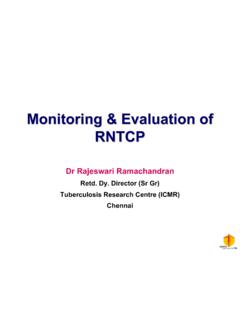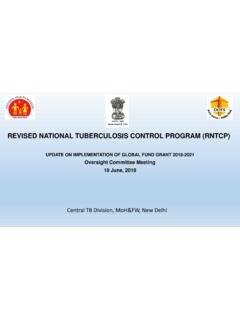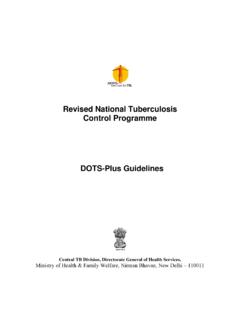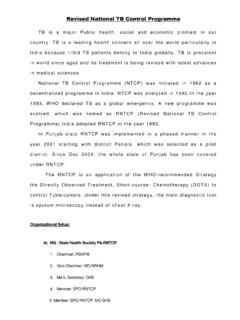Transcription of Revised National Tuberculosis Control Programme
1 Revised National Tuberculosis Control Programme Social Action Plan (Including the Tribal Action Plan) November 2013 Central TB Division, Directorate General of Health Services, Ministry of Health & Family Welfare, Nirman Bhavan, New Delhi 110 108 Contents 1. Introduction (social context, program history, dimensions, social assessment) 2. Progress So Far (targeted interventions for the poor and vulnerable populations) 3. Way Forward: National Strategic Plan ( to address social inclusion issues) 4. Stakeholder Consultations 5. Implementation Arrangements (Disclosure, GRM, M&E) 6. Annex-1: Measures taken on Social Assessment 7. Annex-2 Tribal Action Plan Executive Summary The Revised National Tuberculosis Control Programme (RNTCP), implemented since in 1993, is a part of the Government of India s (GoI) National Health Mission.
2 The GoI has been supported by the World Bank with financing of US$ 115 million (1997-2004) and US$ 179 million (2006-12) and technical support to strengthen RNTCP and its delivery. In the follow up of this, the Government of India is in dialogue with the World Bank to continuing this partnership in its efforts to eliminate TB from the country, envisaged in the National Strategic Plan (NSP) for RNTCP (2012-2017). The relationship between TB and poverty is known: the poor, vulnerable, and marginalized communities- tribal, rural, and urban slum dwelling people are affected disproportionately by TB with severe financial consequences. With this in view, RNTCP has been designed as a socially inclusive program aimed at reaching the unreached.
3 A Social Assessment was undertaken in 2005 and a Tribal Action Plan was developed with measures to better serve vulnerable and marginalized groups in tribal and hard reach areas. A follow-up Social Assessment was carried out in 2011 to identify and bridge gaps in and barriers to full utilization of RNTCP services by the marginalized and vulnerable populations. This Study informed strategies spelt out in the NSP (2012-17) to ensure universal access to quality TB diagnosis and treatment services. This document presents the Social Action Plan including the Tribal Action Plan (TAP) as incorporated in the NSP (2012-2017) and reflected in several guidelines and training modules developed by RNTCP to sensitize service providers towards the poor and vulnerable, especially in the pursuit of assured, early, accessible good quality care for all TB patients in a community.
4 This Social Action Plan is an outcome of stakeholder consultations carry out for the Social Assessment (2011), National consultation held in Delhi to finalize the NSP (2012-2017) in 23rd July 2012, and follow up consultations held at Delhi on October 24, 2013 and at Phulbani, Odisha on November 4, 2013 to take feedback on the draft Social Action Plan. This Social Action Plan with the TAP meets the requirements of the Bank operational Policy The Plan identifies migrants and tribal groups as difficult to reach populations for which gender sensitive approaches will be pursued to provide appropriate, accessible, acceptable and affordable RNTCP services. Identified mechanisms include strengthening of referral linkages for seamless provision of services, especially for migrant populations; use of communication approaches specific to geographic areas and social/cultural contexts; modification of service delivery and budgetary norms to make services more affordable and accessible to special groups; sensitization of providers to the needs of special groups through training and retraining; and involvement of local practitioners/NGOs for provision of care, awareness generation etc.
5 Annex-1 to the Social Action Plan provides an update on steps taken/planned to address issues raised in the Social Assessment of 2011 and Annex-2 presents the Tribal Action Plan (2005) which RNTCP will continue to implement in line with NSP (2012-2017). Introduction: Tuberculosis was declared a global public health emergency in 1993, when an estimated 7-8 million cases resulted in million deaths annually, worldwide. With a rising global population, the disease too has continued to grow with approximately million incident cases as of Of the 22 countries that account for 80% of the worldwide burden, India ranks first in terms of total numbers of incident cases with more than 2 million new cases added each year and 270,000 deaths As the disease becomes resistant to the standard medicines due to misuse of anti-TB drugs and interrupted treatment, drug resistant TB is becoming a bigger challenge for India, with implications for the rest of the world.
6 Despite a three decade long run (1962-1992), Government of India s National Tuberculosis Program met with limited success in addressing the epidemiology of TB in the country. Consequently, in 1993, GoI revamped its strategy for TB Control with the Revised National Tuberculosis Control Program (RNTCP), which piloted the internationally recognized Directly Observed Treatment Short course (DOTS) methodology in five states of India. The success of the pilot, prompted the GoI to expand the program to all districts of the country in 1997. RNTCP demonstrated remarkable results, by 2004, having successfully expanded coverage of DOTS treatment to all districts of India and meeting the global targets for case detection and cure rates (70% and 85% respectively).
7 In 2006, a second phase of RNTCP was initiated, which focused on consolidation of all planned activities, enhancing coverage to address special groups so as to remove inter-district disparities with respect to case detection and cure rates, and initiated multi-drug resistant (MDR) TB services. Since 1997, RNTCP has screened over 55 million people and initiated treatment for over 16 million TB patients. In its efforts to Control TB, GoI has been supported by the World Bank with financing of US$ 115 million (1997-2004) and US$ 179 million (2006-12) and global technical expertise and knowledge to strengthen RNTCP and its delivery. Social Context: TB Disproportionate Burden on the Vulnerable: The relationship between TB and poverty has been much described with the poor, vulnerable/marginalized communities known to bear a disproportionate burden of the disease and severe financial consequences.
8 Studies from India have also reported the increased prevalence of TB among such population groups, with data indicating that about 64% of patients taking treatment under the RNTCP, belonging to poor economic Another study based on an analysis of NFHS 2 data reports that TB prevalence is greatest among the scheduled tribe women ( ). Living conditions also had a bearing on the prevalence of the disease. Factors such as living in kutcha houses and use of smoke-causing fuel for cooking are significantly linked to the prevalence of It is reported that the 1 Regional TB statistics. World Health Organization, 2011. 2 Global Tuberculosis Report. World Health Organization, 2013.
9 Geneva. 3 Muniyandi M, Ramachandran, Balasubramanian, Narayanan. Socio economic dimensions of Tuberculosis Control : review of studies over 2 decades from Tuberculosis Research Centre. J Commun. Dis. 38 (3)2006: 204-215. 4 Kaulagekar A, Radkar A. Social Status makes a difference: Tuberculosis scenario during National Family Health Survey 2. Indian J Tuberc 2007; 54: 17-23. economic cost of illness due to TB in resource poor settings exceeds 10 percent of the household income. Such populations, when afflicted with TB, struggle to cope with the catastrophic economic costs and loss of RNTCP has been successful in bringing down the cost of TB treatment from Rs. 5,986 to Rs. 1,398. Studies report that the Programme is reaching the poor and could be an effective part of an anti-poverty approach to development; however, some marginalized groups such as tribal populations, rural poor and urban slum populations are yet to receive the full benefits of the Social Dimensions of RNTCP a socially responsive Programme : The RNTCP is a part of the GoI s flagship health program the National Health Mission, previously known as the National Rural Health Mission (NRHM), and the TB diagnostic and treatment services are integrated in the government health system nationwide.
10 RNTCP contributes to the National Health Mission s overarching goal of improving availability of and access to quality health care by people, especially those residing in rural areas, the poor, women and children .6 The RNTCP s National Strategic Plan adopts the objective of universal access to quality TB diagnosis and treatment for all TB patients in the community. 7 The National Strategic Plan identifies special groups for which special mechanisms are deployed to make services accessible and acceptable. Migrants and tribal groups have been identified as difficult to reach populations for which gender sensitive approaches will be pursued to facilitate the provision of appropriate, accessible, acceptable and affordable RNTCP services.










